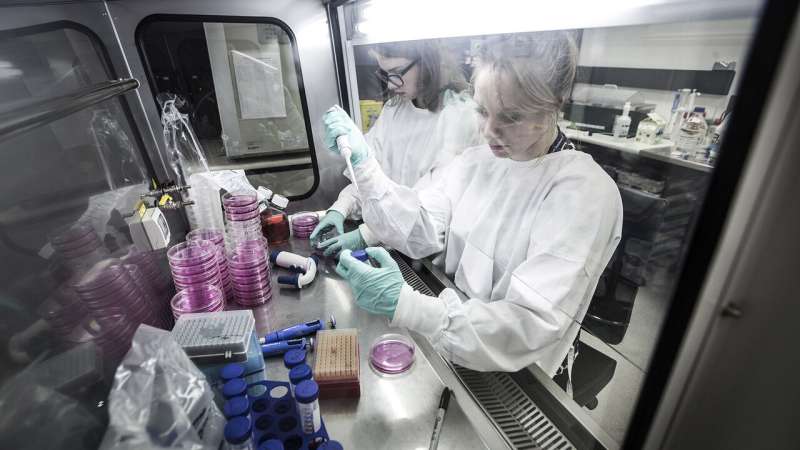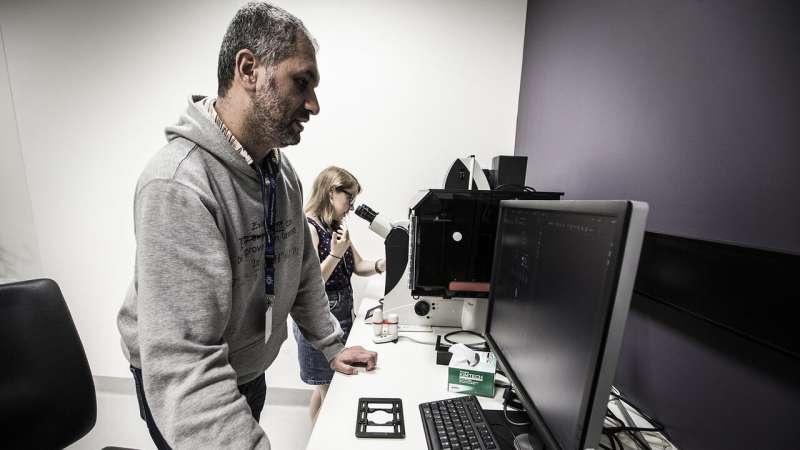University of Wollongong PhD student Elette Engels working at the Australian Synchrotron in Melbourne. Credit: Paul Jones, UOW
A new radiation therapy technique pioneered by scientists from the University of Wollongong's Centre for Medical Radiation Physics (CMRP) has shown promise for improving treatment outcomes in patients with brain cancer.
Working at the Australian Synchrotron facility in Melbourne, the scientists tested a technique for the treatment of high-grade brain cancer using personalized microbeam radiation therapy (MRT), combining it with an innovative assessment of tumor dose-coverage.
MRT uses ultra-fine X-rays—each smaller in diameter than a human hair—to destroying the cancerous tissue while not harming the surrounding healthy tissue. Precise targeting also enables much higher dosages to be delivered to the tumor in a very short time.
The researchers used CT scans, performed at Monash Biomedical Imaging, to map individual brain tumors in rats, and then used MRT to deliver high dose to the cancer cells with pinpoint precision. The synchrotron is able to produce much more powerful X-rays than conventional hospital X-ray machines.
The MRT treated rats survived for significantly longer than non-irradiated rats with the same aggressive brain tumors. No long-term adverse effects were observed following MRT, and there was no noticeable decline in cognition, vision, mobility, or behavior in the treated rats.
The study, which included researchers from the Illawarra Health and Medical Research Institute (IHMRI), Australian Synchrotron—Australia's Nuclear Science and Technology Organisation (ANSTO), Central Coast Cancer Centre and Prince of Wales Hospital, is published in Scientific Reports.
It is the first long-term Australian MRT brain cancer survival study, and the first in the world to look at optimisation of personalized pre-clinical MRT of high-grade brain cancer. The results and methods investigated MRT from multiple points of view including radiation and medical physics, radiobiology, diagnostic imaging, and preclinical survival.
Lead author and UOW Ph.D. student Elette Engels said brain tumors were among the most difficult cancers to treat.
"Brain cancers require more rigorous and novel treatment strategies to overcome their radiation resistance," she said.
"This new MRT technique treats tumors with very narrow wafer-like X-ray blades to deliver very high doses of synchrotron radiation delivered in a very short time.
"This is not feasible with conventional radiotherapy X-ray machines in hospitals. Our research shows that the treatment of tumor cells is much more effective when the radiation dose is delivered using MRT.
Dr Moeava Tehei from UOW's Centre for Medical Radiation Physics. Credit: Paul Jones, UOW
"Our work aims to optimize this technique and personalize the entire procedure, from diagnosis to treatment, for each patient."
Treating brain cancers in children and young adults is especially difficult. Over the past 30 years, treatment outcomes for brain cancer in children and young adults have remained at a stand-still.
Corresponding author Dr. Moeava Tehei said that despite advances in surgical techniques, radiotherapy and chemotherapeutics, brain tumors remain difficult to remove surgically and can be resistant to radiation and drug treatments.
"A breakthrough in the treatment of brain cancer is well overdue," Dr. Tehei said.
"Many brain cancer survivors suffer from cognitive and somatic side effects of the treatment, with increased risks in children.
"Sparing normal tissue from damage is key to improved quality of life for brain cancer survivors."
Personalized synchrotron MRT holds the promise of quicker, more effective treatment of brain cancers.
Current radiation therapy for a brain tumor is typically delivered over several weeks with daily radiation treatments. Instead of hitting a larger area of the brain with lower doses of X-rays, repeated numerous times, the new technique would involve a single dose of ultra high dose rate X-rays, precisely targeted at the cancerous cells.
"A single dose of this personalized synchrotron MRT treatment could be more effective than multiple radiation treatments as they are delivered now. Waiting times and toxic dosage could be eliminated if this technology was available in hospitals," Ms Engels said
While more research needs to be done, with the aim of moving towards clinical trials on human patients, the evidence to date suggests that the techniques trialled in this study will be transferable to human patients.
Ms Engels also wished to thank all co-authors, especially Professor Michael Lerch, head of UOW's School of Physics, and Associate Professor Stephanie Corde, Deputy Director of Radiation Oncology Medical Physics at Prince of Wales Hospital in Sydney, for their significant contribution to the study.
More information: Elette Engels et al. Toward personalized synchrotron microbeam radiation therapy, Scientific Reports (2020). DOI: 10.1038/s41598-020-65729-z
Journal information: Scientific Reports
Provided by University of Wollongong
























